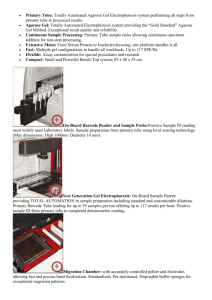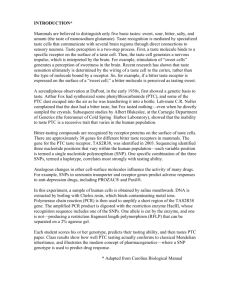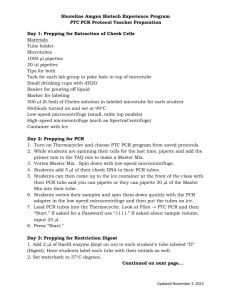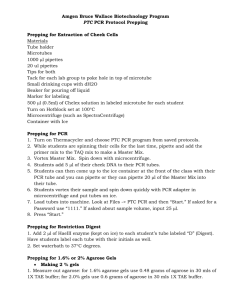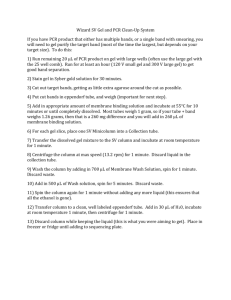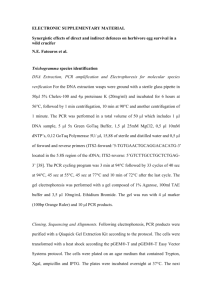File
advertisement
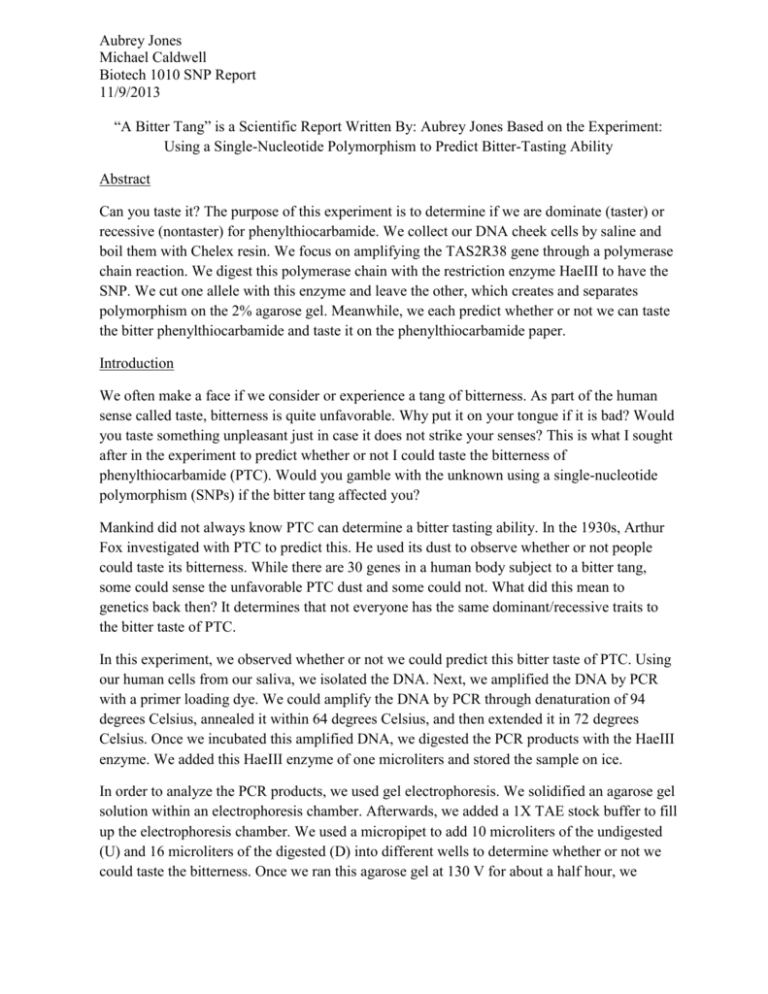
Aubrey Jones Michael Caldwell Biotech 1010 SNP Report 11/9/2013 “A Bitter Tang” is a Scientific Report Written By: Aubrey Jones Based on the Experiment: Using a Single-Nucleotide Polymorphism to Predict Bitter-Tasting Ability Abstract Can you taste it? The purpose of this experiment is to determine if we are dominate (taster) or recessive (nontaster) for phenylthiocarbamide. We collect our DNA cheek cells by saline and boil them with Chelex resin. We focus on amplifying the TAS2R38 gene through a polymerase chain reaction. We digest this polymerase chain with the restriction enzyme HaeIII to have the SNP. We cut one allele with this enzyme and leave the other, which creates and separates polymorphism on the 2% agarose gel. Meanwhile, we each predict whether or not we can taste the bitter phenylthiocarbamide and taste it on the phenylthiocarbamide paper. Introduction We often make a face if we consider or experience a tang of bitterness. As part of the human sense called taste, bitterness is quite unfavorable. Why put it on your tongue if it is bad? Would you taste something unpleasant just in case it does not strike your senses? This is what I sought after in the experiment to predict whether or not I could taste the bitterness of phenylthiocarbamide (PTC). Would you gamble with the unknown using a single-nucleotide polymorphism (SNPs) if the bitter tang affected you? Mankind did not always know PTC can determine a bitter tasting ability. In the 1930s, Arthur Fox investigated with PTC to predict this. He used its dust to observe whether or not people could taste its bitterness. While there are 30 genes in a human body subject to a bitter tang, some could sense the unfavorable PTC dust and some could not. What did this mean to genetics back then? It determines that not everyone has the same dominant/recessive traits to the bitter taste of PTC. In this experiment, we observed whether or not we could predict this bitter taste of PTC. Using our human cells from our saliva, we isolated the DNA. Next, we amplified the DNA by PCR with a primer loading dye. We could amplify the DNA by PCR through denaturation of 94 degrees Celsius, annealed it within 64 degrees Celsius, and then extended it in 72 degrees Celsius. Once we incubated this amplified DNA, we digested the PCR products with the HaeIII enzyme. We added this HaeIII enzyme of one microliters and stored the sample on ice. In order to analyze the PCR products, we used gel electrophoresis. We solidified an agarose gel solution within an electrophoresis chamber. Afterwards, we added a 1X TAE stock buffer to fill up the electrophoresis chamber. We used a micropipet to add 10 microliters of the undigested (U) and 16 microliters of the digested (D) into different wells to determine whether or not we could taste the bitterness. Once we ran this agarose gel at 130 V for about a half hour, we Aubrey Jones Michael Caldwell Biotech 1010 SNP Report 11/9/2013 stained the gel using ethidium bromide. This gel electrophoresis allowed us to be able to see whether or not we could taste the PTC bitterness. Should not we all have the capacity to taste something? We are all humans. However, my genetics make different mistakes from someone else’s genetics. These mistakes are the singlenucleotide polymorphisms, also known as SNPs, which define our distinct features and abilities. So even though SNPs are mistakes, most of them are not bad at all. Would not you prefer not to taste the bitter PTC? As I had predicted an inability to taste PTC through my SNP, this is what I hoped would happen as a result. Materials and Methods Materials Saline mouthwash, paper cup, permanent marker, micropipets and tips, 1.5 ml microcentrifuge tubes, microcentrifuge tube rack, microcentrifuge adapters, microcentrifuge, boiling water bath Methods I labeled a microcentrifuge tube of 1.5 mL and paper cup with my initials using a permanent marker. I poured saline solution into my mouth and vigorously rinsed my cheek pockets for 30 seconds. I expelled the saline solution into the paper cup. I swirled the cup gently to mix the cells. I used a micropipette with a fresh tip and transferred 1000 microliters of solution into my labeled 1.5 mL microcentrifuge and spun it for 120 seconds in a balanced configuration microcentrifuge. I carefully poured off supernatant into the paper cup. I removed most of it and did not disturb the cell pellet at the bottom of the tube. We set a micropipette to 30 microliters and resuspended the cells in the remaining saline by pipetting in and out. I withdrew 30 microliters of cell suspension and added it to a 1.5 mL tube containing 100 mL of chelex. I labeled the cap and side of the tube with my initials and CH beneath them. I placed the tube in a boiling water bath at 99 degrees Celsius for 10 minutes. After boiling, I gently flicked the CH tube for 5 seconds. I placed this tube in a balanced configuration in a microcentrifuge and spun for 120 seconds. I used a micropipette with a fresh tip to transfer 30 microliters of the clear supernatant into a clean 1.5 mL tube. I was careful to avoid pipetting any cell debris and chelex beads. I labeled this tube AJ #2. Amplified DNA by PCR I obtained my PCR tube containing a ready-to-go PCR bead. I labeled it AJ with a marker. I used a micropipet with a fresh tip to add 22.5 microliters of PTC primer/loading dye mix to the tube. I allowed the bead to dissolve for a minute or two. I used a micropipet with a fresh tip to add 2.5 microliters of cheek cell DNA directly into the primer/loading dye mix. I placed the PCR tube in boiling water. I completed 30 cycles. I stored my amplified DNA with the other Aubrey Jones Michael Caldwell Biotech 1010 SNP Report 11/9/2013 students’ DNA at -20 degrees Celcius. I labeled a 1/5 mL tube with my initials and a U for undigested. I used a micropipet with a fresh tip and transferred 10 microliters of my PCR product to the tube. I added 1 microliter of restriction enzyme HaeIII directly into the tube when it was supposed to be in pcr product tube. I put the U tube in the water bath at 37 degrees Celcius. Meanwhile, we sealed the ends of a gel-casting tray with masking tape, and inserted a well-forming comb. We pour 2% agarose solution to a depth that covers about ½ the height of the open teeth of the comb. We allowed the gel to solidify completely. After an hour, I removed my U tube from the water bath of 37 degrees Celcius. I placed the gel into the electrophoresis chamber and added enough 1X TAE buffer to cover the surface of the gel. I carefully removed the comb and added an additional 1X TAE buffer to cover the surface of the gel and filled in the wells—creating a smooth buffer surface. I used a micropipet with a fresh tip and loaded 20 microliters of pBR322/BstNl size markers into the far left lane of the gel. I used a micropipet to add the undigested and digested loading sample dye mixture into different wells of 2% agarose gel. We ran our gels at 130V for approximately an hour. Afterwards, we took out the 2% agarose gel and took pictures of it. Results In order to find out whether or not you are a taster, first you must look at whether or not the TAS2R38 Gene cut through the PCR Amplification. In an agarose gel, if there are two illuminated fragment sizes in a lane (TT, double dominant) then that means the PCR Amplification cut your TAS2R38 Gene. In other words, you are a very strong taster. You must have at least one 2 fragment sizes in a lane in order to be a taster. This indicates whether or not you are a Tt (single dominant/single recessive). The final option is to have two single strands or a tt (double recessive). Throughout the process, I had predicted I was a tt nontaster. According to the agarose gel, I am a tt nontaster, which means I should not taste the bitterness. But when I tasted the paper with PTC, I could taste a moderate bitterness, which means the agarose gel is wrong. Enzyme Activity at Various Temperatures Aubrey Jones Michael Caldwell Biotech 1010 SNP Report 11/9/2013 Legend: First two are my partner’s undigested and digested samples in that order. My undigested and digested samples are the last two slots on the picture. Discussion The only mistake I made in the experiment is that I accidently switched my undigested and digested microcentrifuge tubes. I still added in the correct contents, however. So as the picture explains I am a non-taster, I am actually a moderate taster. I can think of two options to how this came to be. First, the experiment works 95% of the time and I am in the 5% range where it fails. Should I still trust the experiment? I believe so. If it works 95% of the time then that is a strong chance that if I were to repeat the experiment than perhaps my results would change. Secondly, I could have just a much stronger subjective rather than objective result to the PTC bitterness. Perhaps I am just sensitive to the taste and actual experience is more important than an experiment written down on paper. Who is to say my saliva compared to the rest of society can actually account for whether or not I can taste something bitter? In summary, I would have to either repeat this exercise for the reason that it was true for everyone else or find a better experiment to verify the accuracy of my results.


